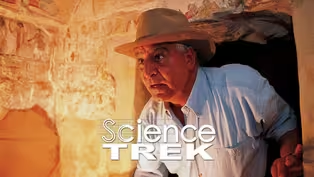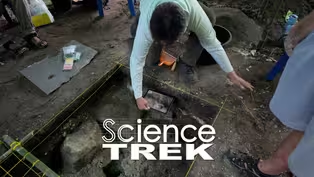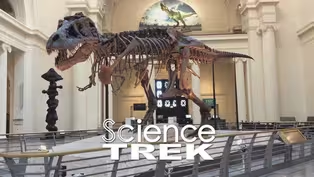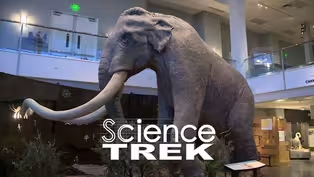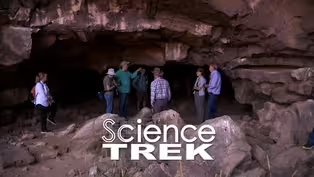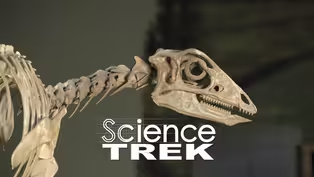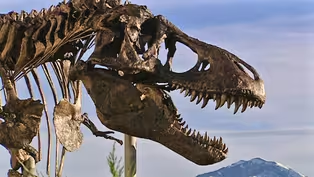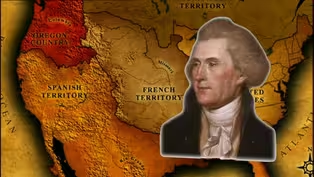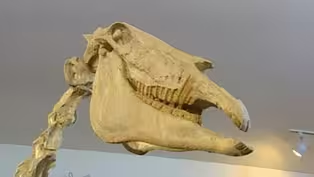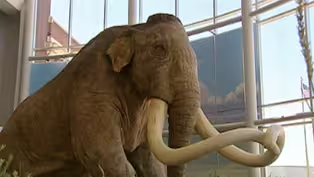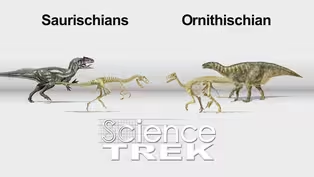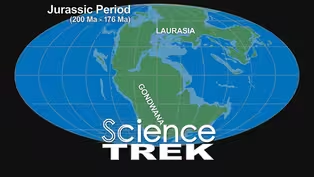
Dinosaurs: Dinosaurs in Idaho
Special | 5m 44sVideo has Closed Captions
What kind of dinosaurs are found in Idaho?
Scientists once thought there were no dinosaur bones to be found in Idaho but that is no longer true. Join the Science Trek team on a hunt for an Idaho dinosaur.
Problems playing video? | Closed Captioning Feedback
Problems playing video? | Closed Captioning Feedback
Science Trek is a local public television program presented by IdahoPTV
Major Funding by the Laura Moore Cunningham Foundation and the Idaho National Laboratory. Additional Funding by the Friends of Idaho Public Television and the Corporation for Public Broadcasting.

Dinosaurs: Dinosaurs in Idaho
Special | 5m 44sVideo has Closed Captions
Scientists once thought there were no dinosaur bones to be found in Idaho but that is no longer true. Join the Science Trek team on a hunt for an Idaho dinosaur.
Problems playing video? | Closed Captioning Feedback
How to Watch Science Trek
Science Trek is available to stream on pbs.org and the free PBS App, available on iPhone, Apple TV, Android TV, Android smartphones, Amazon Fire TV, Amazon Fire Tablet, Roku, Samsung Smart TV, and Vizio.
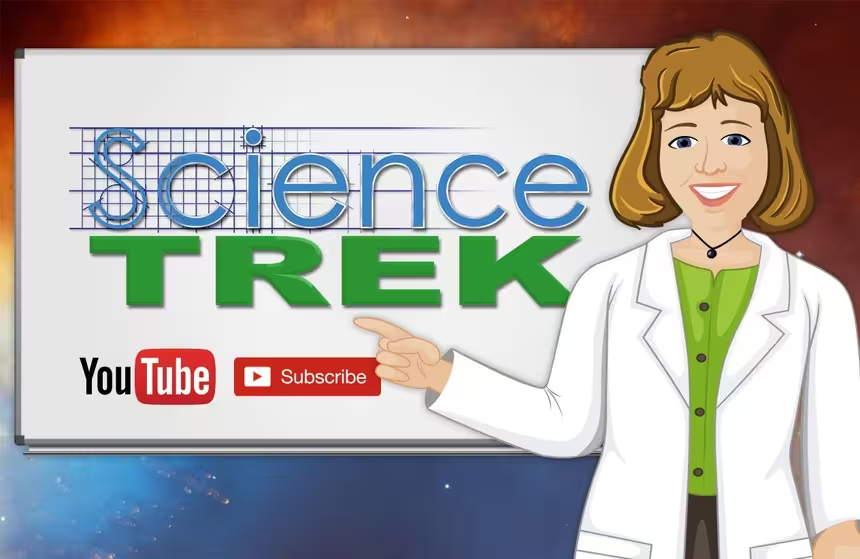
Science Trek
Science Trek is a place where parents, kids, and educators can watch short, educational videos on a variety of science topics. Every Monday Science Trek releases a new video that introduces children to math, science, technology, engineering, and math (STEM) career potentials in a fun, informative way.More from This Collection
Scientists study things left behind to tell the story of what happened in the past. Paleontologists look at bones to help us understand how ancient creatures once survived. Archaeologists and anthropologists study how people lived hundreds or even thousands of years ago. Find out more about what took place in ages past.
Archaeology: Digging into the Past
Video has Closed Captions
What does a mummy smell like when it is first discovered? (7m 16s)
Archaeology: PEMSEA Field School
Video has Closed Captions
Learn about the excavation process of archaeology as Dr. Peter V. Lape and his team dig up the past. (6m 29s)
Video has Closed Captions
Scientists think there were ten different species of Mammoths. What were they like? (5m 51s)
Mammoths: Archaeologist and Paleontologists
Video has Closed Captions
What kind of scientists study Mammoths? (6m 43s)
Skeletons: Just How Do They Know It’s A Dinosaur?
Video has Closed Captions
Paleontologists study skeletons to learn about ancient species. (6m 12s)
Video has Closed Captions
What does a dinosaur egg look like? Find out here! (28m 49s)
Video has Closed Captions
What did archaeologists learn about life in Egypt from King Tut’s tomb? (28m 57s)
D4K: The Science of Lewis and Clark
Video has Closed Captions
Lewis and Clark made major scientific discoveries on their journey West. What were some? (28m 49s)
Providing Support for PBS.org
Learn Moreabout PBS online sponsorship[MUSIC] Joan Cartan-Hansen, Host: Hi I'm Joan Cartan-Hansen.. And welcome to Science Trek.
I have some guests with me today.
Maya, and Paleontologist L.J.
Krumenacker.
We're gonna go hunting for dinosaurs.
Let's go.
Cartan-Hansen: So why have no real big dinosaur finds been found in Idaho?
Krumenacker, Paleontologist: That's a good question.
You think of places like Utah or Montana where you have your big giant, you know, ridiculous dinosaurs, and I think for a long time people came out here expecting to see that and we didn't.
And I think part of the reason for that is probably there was some sort of process going on as these rocks formed where big bones didn't get buried fast enough to get preserved.
They just rot away and get destroyed.
When you are looking for dinosaur bones, you need to find rocks kind of the right age, from the age of dinosaurs.
Cartan-Hansen: You also need to look near rivers or streams, and Krumenacker found something here.
Krumenacker: Right.
Here's the vertebra poking out of the rock, just starting to come out with probably, hopefully more bones in.
Cartan-Hansen: We're joined by fellow paleontologist Ashley Ferguson.
Krumenacker: I'm going to have to peck around in some of these cracks to see how helpful the rock is, so we can get it.
[HAMMERING] Krumenacker: This is a tailbone probably from this little dinosaur living in its burrow called Oryctodromeus.
It's the most common Idaho dinosaur.
It's a plant-eater, maybe about 10-11 foot long, about a seven-foot tail, ran around on two legs, and again it lived in the burrows with its kids.
[CHISELING] Krumenacker: Trying to avoid damaging it.
Right now, I'm just trying to see where we might have some loose cracks to work around it, and hopefully get it out in one piece.
[CHISELING] Krumenacker: I mean, if it comes out in two or three decent pieces, that's not bad.
[HAMMERING] Krumenacker: Trying to dig it out of the rock is really hard, so I'm going to have to come back and put a lot more work into it.
We also found another bone poking out.
So I suspect, as we get into this, if we are lucky, we'll have a partial skeleton.
Cartan-Hansen: So, we decide to move to another site.
This time, we are looking for dinosaur egg shells.
Ashley Ferguson, Paleontologist: Looks like there's an eggshell piece there.oh no, never mind that's a rock!
Krumenacker: Keep looking, there are probably more.
Ferguson: There's a small piece.
Krumenacker: Here's a little piece of eggshell.
Maya: Is there one right here?
Ferguson: Yep, there's a good piece.
Krumenacker: Yup, good eye, you're doing good.
Ferguson: Oh, here's a nice piece.
See how bumpy they are?
Kind of weird, huh?
Cartan-Hansen: These eggs are from an oviraptorosaur.
Krumenacker: Imagine like a big chicken with fingers and claws and kind of a long-feathered tail that might eat you.
We call it the killer chicken or the boneless chicken 'cause we find the eggs, but we haven't been able to find the bones.
Ferguson: Eggs are important because it helps us learn how the animal grew and how they care for their young.
It's a way to learn how the animal lived.
So in a way, for me, it's important because it makes the animals more real.
Krumenacker: Good job Maya, you found a lot.
Cartan-Hansen: The dinosaur egg shells will be taken to the Idaho Museum of Natural History for study.
We go on to our last dinosaur site of the day.
KRUMENACKER: So, where we are standing right here, you wouldn't have any idea, this is the most important well, at least one of the most important dinosaur spots in Idaho.
It's called the Robinson Bone Bed.
Cartan-Hansen: The forest service was going to put a road through this area when Krumenacker found dinosaur bones.
Krumenacker: You've got out here teeth from an ancestors of T-rex, you've got little raptor teeth, even a little tiny raptor tooth from some sort of a raptor the size of a crow.
Of course, you have lots of Oryctodromeus bones.
Cartan-Hansen: So, the forest service set aside the rocks from the hillside and put them in a field for paleontologists to study.
Krumenacker: The big problem is when they first dumped all the rock here, it was actually piles of rock, that's all that was here.
But the past three, four years it's just totally overgrown with plants, so every year it gets harder and harder to work here.
Cartan-Hansen: So, you can see between having to chisel fossils out of a stone or finding rocks hidden by plants, a paleontologist's work isn't easy.
But Krumenacker says he loves it.
Krumenacker: If I were 8 or 10 like one of my kids and thinking about becoming a paleontologist, I would probably think one of the best things about it is that you get to play outside all day in the summer.
So, you get to travel.
If you're lucky, you get paid for what you are doing, you get to meet other students, and teach other people.
I like teaching.
So, it's a good way to play outside, a good way to learn, and a good way to meet other people.
Cartan-Hansen: You can learn more about dinosaurs by checking out the dinosaur site on the Science Trek website.
You'll find it at ScienceTrek.org [MUSIC] ANNOUNCER: Presentation of Science Trek on Idaho Public Television is made possible through the generous support of the Laura Moore Cunningham Foundation, committed to fulfilling the Moore and Bettis Family legacy of building the great state of Idaho; by the Idaho National Laboratory, mentoring talent and finding solutions for energy and security challenges; by the Friends of Idaho Public Television; and by the Corporation for Public Broadcasting.
Video has Closed Captions
Clip: Special | 1m 4s | Look to the hips to classify dinosaurs. (1m 4s)
Dinosaurs: Plates and What We Don't Know
Video has Closed Captions
Clip: Special | 1m 4s | How has the Earth changed since the time of dinosaurs? (1m 4s)
Providing Support for PBS.org
Learn Moreabout PBS online sponsorship
- Science and Nature

Capturing the splendor of the natural world, from the African plains to the Antarctic ice.

- Science and Nature

Explore scientific discoveries on television's most acclaimed science documentary series.












Support for PBS provided by:
Science Trek is a local public television program presented by IdahoPTV
Major Funding by the Laura Moore Cunningham Foundation and the Idaho National Laboratory. Additional Funding by the Friends of Idaho Public Television and the Corporation for Public Broadcasting.
